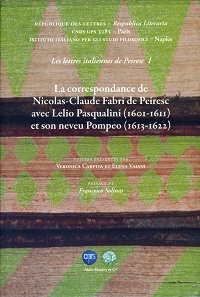by Ursula Kampmann
translated by Christina Schlögl
February 22, 2018 – There are few areas of numismatics that are as intensely researched as the history of science. And we don’t just learn new things about coins, gems and other ancient objects. We mostly begin to understand how scientific results were spread in a world in which the horse was the fastest means of transportation. We learn that our beloved books, which are now the preferred method of conveying research results, were not the only way scholars chose to express their findings. During the Early Modern Age, correspondence was much more important to obtain information and pass on new insights. The correspondence between Nicolas-Claude Fabri de Peiresc and Lelio Pasqualini resp. his nephew Pompeo Pasqualini is a good example for this exchange of knowledge.
Veronica Carpita, Elena Vaiani (Ed.), La correspondance de Nicolas-Claude Fabri de Peiresc avec Lelio Pasqualini (1601-1611) et son neveu Pompeo (1613-1622), Les lettres italiennes de Pereisc 1. CNRS/Alain Baudry et Cie, Paris 2012. 16.2 x 24 cm. 345 p. Paperback. ISBN: 978-2-35755-038-4. 53 euros.
Nicolas-Claude Fabri de Peiresc (1580-1637) is famous enough to have Wikipedia entries in nine different languages. However, he did not write important books during his lifetime to achieve this. He mostly spread his knowledge through letters to many famous contemporaries: He wrote to the French poet Francois de Malherbe for instance, the Dutch jurist Hugo Grotius, to whom we owe the idea of a free sea, the Flemish painter Peter Paul Rubens or the Italian astronomer Galileo Galilei.
When Peiresc wanted to talk to someone about coins and iconographic questions though, he would mostly write to Lelio Pasqualini (1549-1611), who became his numismatic teacher, or to his nephew Pompeo, although not many letters of the latter have been preserved.
Veronica Carpita and Elena Vaiani have thankfully gathered all these letters from different libraries, transcribed them and written comments. They have equally distributed the work among themselves: Letters I-XXVIII have been commented by Veronica Carpita, letters XXIX through XLIX by Elena Vaiani. The authors have thus offered us an outstanding insight into the scholars’ topics of conversation and their intense and detailed discussions. Elena Vaiani summarises them in one comprehensive chapter. They debated the location of the ancient Mons Argaios and the harbour of Trajan, small antiquities and gems, rare coins, the mint marks of coins from the late antiquity, the cross on the coins of Constantine and questions of iconography.
If you would like to know more about these letters, which truly indicate the high level of exchange of ideas, you are welcome to read them yourself. Both researchers were best informed on the latest developments of numismatics. They read the newest books, they were familiar with the methodology and they had a profound and simply admirable knowledge of the material.
The book has an introduction by Francesco Solinas and an article by Veronica Carpita that is dedicated to the rather unknown biography of Lelio Pasqualini. It also features an extensive index to navigate the material.
This index quickly offers proof of the international relationships of these scholars. Peiresc and Pasqualini were familiar with Adolph Occo and Marcus Welser from Augsburg, for instance, who were the center of a network of Southern German and Swiss antiquarians.
Consequently, this book shows that transnational science is not a modern privilege. On the contrary. The invisible ‘Republic of Letters’, which has left its traces in countless letters – there are around 10,000(!) of Peiresc alone – worked so smoothly that we might even get a little jealous when comparing it to our contemporary Cultural Assets Protection Act Europe.
You can buy this book via Amazon. Please note that Amazon has different prices for it!
The book can be purchased cheaper on this French website.





